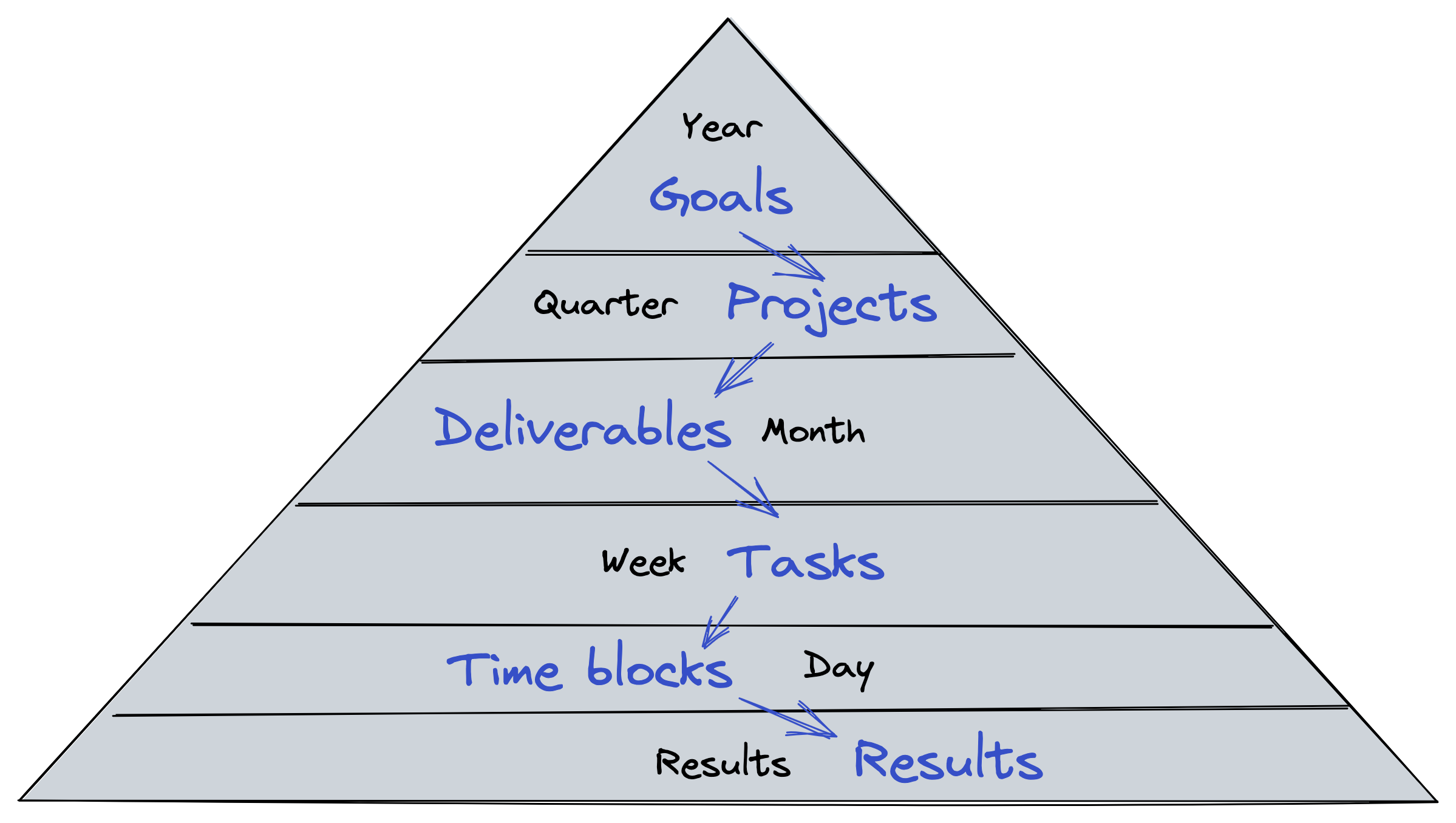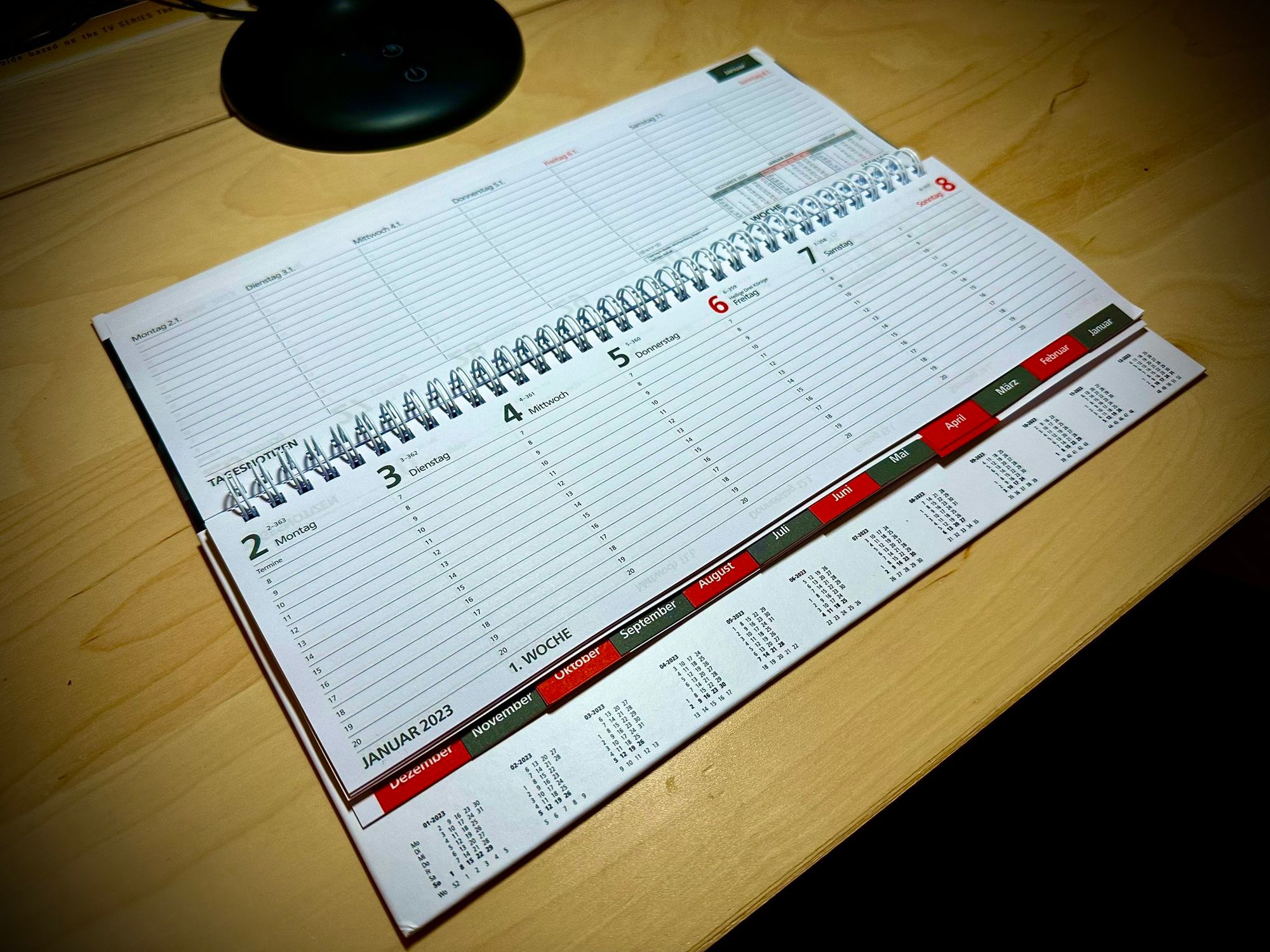How to plan your goals for 2023 in an afternoon?
Use time horizons to plan your goals in a balanced way that is neither too complex nor too simple. Set goals for the year, projects for the quarter, deliverables for the month, and tasks for the week. Only plan in detail for the immediate time frame and leave the rest unplanned.

New Year, New Happiness. The end of a year, or the new beginning of a New Year, is an excellent opportunity to create a mental tabula rasa and plan your intentions for the coming year.
There are several wrong approaches you can take:
- If you have rough New Year's resolutions without structuring the implementation, that's not enough of a system.
- If you build a complex database schema in Notion (or a similar tool) with inheritance structures of goals, KPIs, projects and corresponding GANTT charts, this is too much system and useless in practice.
I want to suggest a balanced system that is neither too complex nor too simple. I managed to complete in one afternoon my planning for 2023, the first quarter, the first month and the following week (= four notes). It’s a quick and practical approach because we only plan what’s important now and nothing else.

Think at planning levels
I plan my roadmaps in graduated time horizons, where each level reflects a planning granularity:
- The year: goals
- The quarter: projects
- The month: deliverables
- The week: tasks
- The day: time blocking
It’s important to note that you don’t want to plan your year in too much detail. For example, for planning in early January of 2023:
- Regarding the whole year, you plan only the goals
- Quarters 2-4 aren’t planned at all; you plan only the projects for the first quarter.
- You plan only the deliverables for January. Every other month can be left aside.
- You only derive concrete tasks for the coming week
- etc.
The planning for the later points in time is then done as follows:
- The following week: this Sunday.
- The next month? January 31th
- The next quarter? March 31th
- The next year? December 31th

Year-Level: Set your goals for the year.
Goals reflect your desires. I have a list of roles and areas of life that I use to think about my goals:
Self
- Lifestyle & Leisure
- Home & Household
- Family, Friends & Relationships
- Knowledge & Learning
- Health & Fitness
Worker
- Innovation Management
- Intrapreneurship
- Strategy Enablement
Privateer
- Finances, Savings & Investments
- Creation & Art
- Entrepreneurship
In my case, I have identified 15 goals in these areas that I want to achieve in 2023 (honestly, a bit too many, but what the heck). I wrote these down as a table in a note titled "2023 (Goals)".
Here are five examples:
- I reduce and maintain my weight to 99kg and eat a balanced, non-industrial and largely sugar-free diet 2/3 of the days.
- I increased my invested capital to xxk€ and saved on average xxx€ per month.
- I raised xxxk€ Ebit / month for my employer by implementing Project XYZ.
- I earn 500€/month side-gig income through Deliberate-Diligence.com
- I learn to play the first song on guitar, ukulele or e-piano
When formulating goals, I make sure that they are crafted in a way that is reasonably tangible and measurable, but I also don't stress about it.

Quarter-Level: Translate the first part of your goals into concrete projects for the next quarter
When you think about your annual goals, you may come up with goals that are larger than the ones you can manage at any time.
Therefore, it is worthwhile to put the goals in order and start by addressing only a portion of them concretely in the next quarter. I formalise this by translating them into projects.
Projects answer the WHEN and HOW of a goal.
Every project should pay in on at least one goal (why else would you do the project?), or sometimes you can even tackle several goals simultaneously with the same project (domino effect).
Here are a few examples of how such projects might look:
- You want to lose a few kilos? One project could be to do 45 minutes of exercise every day for 100 days (half weight training, half endurance), and another project could be to establish a routine of cooking fresh food every day and avoiding industrially processed foods.
- You want to lift an opportunity for your employer or solve a problem? Then plan the analysis phase first, in which you block out committed time boxes each week and begin with brainstorming and stakeholder interviews. The first result would be a presentation of your analysis results.
- You want to be creative and create art? Then set yourself an experiment in which you try to implement four iterations of the artwork you have in mind in 4 weeks. Of course, if you're unpracticed, this won't look like what you envision at first, but the four rounds of practice are tangible and will move you forward tremendously
Goals and projects can sometimes sound similar and flow into each other. The difference is that Goals could be non-actionable desires. Still, your projects need to be concretely executable, and you have thought about a strategy for HOW you will execute them in principle.
Document your projects in a note for the quarter ("2023-Q1" for example) and also create another note for each project (e.g. „P Daily Exercise Hour").

Month-Level: Set your sights on completing specific deliverables.
Projects can be as comprehensive as goals. You can rarely set out to „finish“ a project in a month or even a week.
That's why I've started thinking about the specific deliverables I need to create for each project. And I try to structure and cut these deliverables so that each can be done within a month.
Each deliverable is assigned to precisely one project and one month. On the other hand, a project can have multiple deliverables that span multiple months.
Here are another couple of examples:
- If I have the goal to lose 12 kg in the whole year, the first deliverable for the next month is to lose 1 kg of body fat.
- If I want to earn pocket money with my blog, I’ll start writing three blog articles weekly, so 12 articles per month. Not to generate immediate sales with it but to test how it goes, how to write, and what I want to write about.
- When I'm working on a big work project, my monthly deliverable is often a set of slides summarising Progress, Plans, and Problems. Good ideas and clarity about the project often come to me while writing this slide set. It is a good idea to create a presentation at the end of a milestone and present it to the stakeholders (for example, the end of the analysis phase with the analysis results and my proposals for further action, including scenario considerations).
My old boss used to say: "So, now we have to lay an egg on topic XY". What he meant by this was precisely that: complete something (in case of doubt, an interim status) as a deliverable and thereby make progress tangible.
Unfortunately, this is somewhat hidden in this blog article, but in my opinion, this is the reason for a lot of dissatisfaction among knowledge workers. They are often dissatisfied because they don't see their progress. They crave physical tasks like mowing the lawn, where you can immediately see the results and progress afterwards.
If you, as a knowledge worker, consistently break down your goals first into projects and then deliverables and record the completion of those in a journal or success log, you can create this lawn-mowing effect in knowledge work as well.

Week-level: Put deliverables and tasks together into an overall picture for the week.
We’re already leaving strategic planning and are more operationally planning our upcoming week. Of course, some deliverables pay off your goals, but many other tasks, duties and ideas need to be implemented just like that - without any strategic goals.
For me, it is often the case that there are 6-12 other tasks for every deliverable.
In weekly planning, creating a good balance between the deliverables and the other tasks is vital.
I handle this as follows:
- I make sure that for each deliverable, I am clear about the next step that I can complete within one morning of a day. Thinking through this is part of a weekly planning review.
- Each day of the week is assigned 1x deliverable, 2x medium tasks and 5x small tasks.
- Assigning a deliverable to a day means that I work an obligatory 2,5 hours in an "Eat the Frog" timebox directly in the morning between 09:00 and 11:30. This is often enough to get the next step or sometimes even the entire deliverable off the table.
- The rest of the tasks I do in the afternoon. Completing the "Eat the Frog" timebox is sacred to me. I’m not strict about getting the smaller and medium tasks done as planned. If something doesn't fit into my flow, I move it to another day or even to my "Somewhen" backlog. If I have hard deadlines, this is, of course, not possible. The day was a success as soon as I worked on my Deliverable in the Eat the Frog timebox. This way, my day can be already successful right at noon.
Within the week, I try to work exclusively with my weekly note (e.g., „2023-Q1-CW02"). If new tasks come in during the week, I first push them into the backlog and not into my weekly notepad to not dilute my initial planning.
The nice thing is that there are well-thought-out structures in the background (annual goals, projects, deliverables), but I don't have to burden myself with them during the week, but I only have the things in front of my eyes that are important right now.
At the end of the week, a review of the weekly list takes place. What went well (=successes?), what did not (=fails?). I record this in a journal. I deal with tasks that have been left undone in one of the following three ways:
- I discard them
- or I move them to the next week's note to be scheduled again immediately
- or I move them back into my backlog to be scheduled again for a week at some point.
Another thing I think is essential to mention about the weekly schedule is that it is not sacred. There are also weeks where I think about the plan for the week on Sunday, and then I do something completely different within the week. Then that's just the way it is, in case of doubt, your gut feeling gives you a better idea of what is the most important thing you have to do at that particular moment.
And if your gut feeling doesn't tell you anything, then you have your weekly list, where you can see immediately what needs to be done.

Day-Level: Use the day for implementation
The last "planning level" is then the concrete day. Here, however, it is ideally no longer about the planning but only about the execution. Ideally, you don't have to think about your goals, plans, deliverables and tasks for a second during the workday. Instead, you have precisely one "Eat the Frog" (the next step of a deliverable) for the morning and a small number of other tasks for the rest of the day. And then you have to work through them.
There is only one thing to keep in mind: Time blocking. Especially for busy people, it probably won’t get done if something is not on the calendar.
This is not possible for everyone (e.g. if you have to react a lot in your job, for example, to issue tickets, you can't block and plan much in advance), but at least for many people.
I handle it as follows:
- My "Eat-the-Frog" timebox is a serial meeting, daily from 09:00 to 11:30, which I rigorously defend from meetings and for which I reward myself with a walk from 11:30 to 13:00.
- For the other tasks (>15m), I set blockers in my calendar, which are between 30-60 minutes long.
- Smaller tasks I don't block in my calendar at all, I do them when it fits.

Conclusion / Summary
In conclusion, finding a balanced approach to goal planning is crucial that is neither too complex nor too simple.
By thinking at different planning levels, setting goals for the year, translating them into projects for the quarter, and breaking down tasks for the week and day, you can effectively plan for the coming year quickly and practically.
Scheduling planning sessions at various intervals allows you to reassess and constantly adjust your plans as needed. By focusing on what is important now and not overplanning, you can achieve your goals and progress towards your desired outcomes.
Feel free to add your tips and thoughts to this page's comment section, Twitter or LinkedIn!
Best regards,
-- Martin from Deliberate-Diligence.com

Discussion